The weakness of "security through obscurity" is so well known as to be obvious. Yet major hardware manufacturers, citing the need to protect intellectual property, often require a non-disclosure agreement (NDA) before allowing access to technical documentation. The situation has become even more difficult with the growing intricacy of chip designs and integration of proprietary firmware. Such obstacles make it nearly impossible for independent researchers to analyze the security of these platforms. As a result, both ordinary users and hardware manufacturers lose out.
One example is Intel Management Engine (Intel ME), including its server (Intel SPS) and mobile (Intel TXE) versions (for background on Intel ME, we recommend consulting [5] and [6]). In this article, we will describe how undocumented commands (although "undocumented" applies to practically everything about Intel ME) enable overwriting SPI flash memory and implementing the doomsday scenario: local exploitation of an ME vulnerability (INTEL-SA-00086). At the root of this problem is an undocumented Intel ME mode, specifically, Manufacturing Mode.
What is Manufacturing Mode?
Intel ME Manufacturing Mode is intended for configuration and testing of the end platform during manufacturing, and as such should be disabled (closed) before sale and shipment to users. However, this mode and its potential risks are not described anywhere in Intel's public documentation. Ordinary users do not have the ability to disable this mode, since the relevant utility (part of Intel ME System Tools) is not officially available. As a result, there is no software that can protect, or even notify, the user if this mode is enabled for whatever reason. Even Chipsec [2], a utility specially designed to identify configuration errors in the chipset and CPU at the level of UEFI firmware (such as incorrect configuration of access rights for SPI flash regions), does not know anything about Intel Manufacturing Mode.This mode allows configuring critical platform settings stored in one-time-programmable memory (FUSEs). These settings include those for BootGuard (the mode, policy, and hash for the digital signing key for the ACM and UEFI modules). Some of them are referred to as FPFs (Field Programmable Fuses). For a list of FPFs that can be written to FUSEs (a list that is incomplete, since a number of FPFs cannot be set directly), you can use the FPT (Flash Programming Tool) utility from Intel ME System Tools.
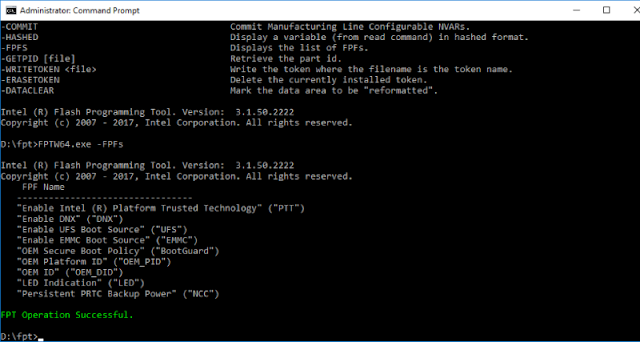 |
| Figure 1. Output of the -FPFs option in FPT |
In addition to FPFs, in Manufacturing Mode the hardware manufacturer can specify settings for Intel ME, which are stored in the Intel ME internal file system (MFS) on SPI flash memory. These parameters can be changed by reprogramming the SPI flash. The parameters are known as CVARs (Configurable NVARs, Named Variables).
Setting CVARs is the responsibility of the Intel ME module named mca_server. MCA is short for "Manufacture-Line Configuration Architecture," which is the general name for the process of configuring the platform during manufacturing. CVARs, just like FPFs, can be set and read via FPT.
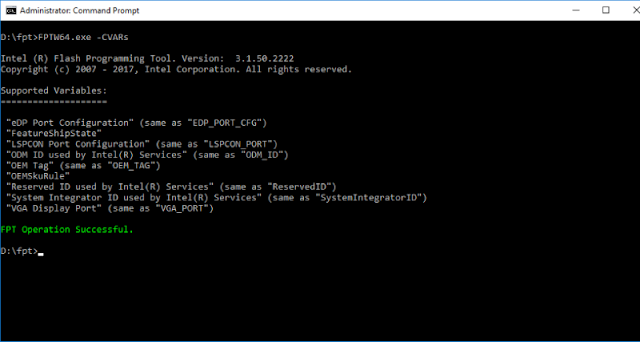 |
| Figure 2. List of CVARs output by FPT for the Broxton P platform |
Setting FPFs, or almost any CVARs, requires that Intel ME be in Manufacturing Mode. The process of assigning FPFs consists of two steps: setting the values for FPFs (which are saved to temporary memory) and committing the FPF values to the FUSEs. The first step is possible only in Manufacturing Mode, but the actual "burn" occurs automatically after Manufacturing Mode is closed if, while in that mode, the manufacturer set FPF values and the corresponding range in the FUSE array has never been written to before. So, if a system is in Manufacturing Mode, the FPFs have likely never been initialized.
A sign of Manufacturing Mode having been closed is stored in the file /home/mca/eom on MFS. When the SPI flash is overwritten by firmware with the basic file system (just after build by FIT [9]), the platform can once again function in Manufacturing Mode, although overwriting FUSEs is no longer possible.
OEM public key
Accordingly, the procedure for configuring Intel platforms is rather complicated and consists of multiple steps. Any error or deviation from this procedure by hardware manufacturers places the platform at serious risk. Even if Manufacturing Mode has been closed, a manufacturer may not have set FPFs, which allows attackers to do so themselves by writing their own values for example instead of the key for signing the start code of the BootGuard (AСM) and UEFI modules. In this case, the platform would load only with the attacker's malicious code—and persistently so. This would lead to irreversible hardware compromise, since the attacker's key is written to permanent memory, from which it can never be removed (for details of this attack, see "Safeguarding rootkits: Intel BootGuard" by Alexander Ermolov [8]).On newer systems (Apollo Lake, Gemini Lake, Cannon Point) FPFs store not just the key for BootGuard, but the OEM's public key (strictly speaking, the SHA256 hash for the RSA OEM public key), which underpins several ME security mechanisms. For example, the special section of SPI flash named Signed Master Image Profile (SMIP) stores manufacturer-specified PCH Straps (PCH hardware configuration). This section is signed using a key whose SHA256 hash is stored in a special file (partition) on SPI flash. This file name is oem.key in the FTPR partition (OEMP.man in OEMP partition for Cannon Point PCH) and contains various OEM-provided public keys for signing all sorts of data. In the following figure, you can see a full list of the sets of data signed by the manufacturer, each with a unique key, for the Cannon Point platform:
 |
| Figure 3. List of OEM-signed data for the CNP platform |
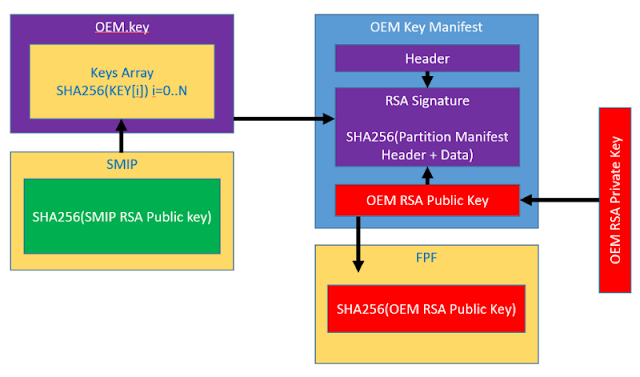 |
| Figure 4. OEM signing |
Bypassing block on writing to the ME region
Until recently (prior to Intel Apollo Lake), Intel ME was located in a separate SPI region that had independent access rights for the CPU, GBE, and ME. So as long as access attributes were correctly configured, it was impossible to read or write to ME from the CPU (main system) side. However, current SPI controllers for Intel chipsets have a special mechanism called Master Grant. This mechanism assigns a strictly defined portion of SPI flash to each SPI master. A master controls its particular region, regardless of the access rights indicated in the SPI descriptor. Each master can provide access (read or write) for its region (but only its own region!) to any other master it wishes.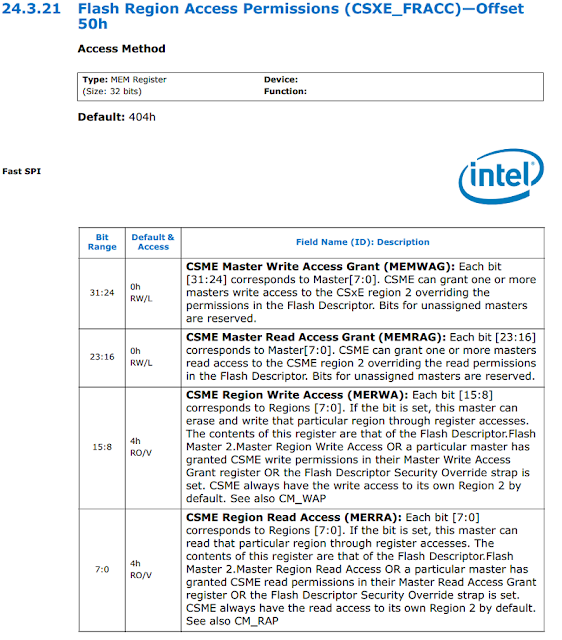 | |
| Figure 5. Excerpt from Intel documentation describing SPI Master Grant |
Host ME Region Flash Protection Override
Intel ME implements a special HECI command that allows opening write access to ME SPI region on the CPU side. The command is called HMR FPO (Host ME Region Flash Protection Override). We have detailed this command at length previously [5]. There are some things worth knowing about it.After receiving the HMR FPO command, Intel ME opens access to the region only after a reset. Intel МЕ itself also includes security measures: the command is accepted only when the UEFI BIOS is owner of the platform boot process, prior to End Of Post (EOP). EOP is a different HECI command that sends the UEFI to ME before handing off control to the operating system (ExitBootServices). Sometimes, BIOS Setup contains an option for sending the HMRFPO command prior to EOP.
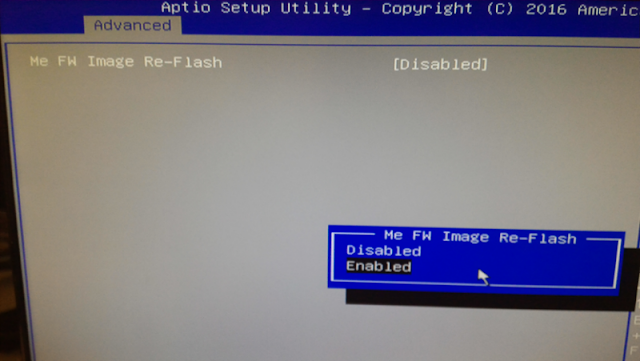 |
| Figure 6. Opening the ME region in the BIOS |
Resetting ME without resetting the main CPU
Today's computers can be restarted in several different ways: the documented versions include a global reset and reset of the main CPU only (without resetting ME). But, if there is a way to reset ME without resetting the main CPU (by running the HMRFPO command in advance as well), access to the region opens up and the main system continues to function. |
| Figure 7. Reset types |
Having investigated the internal ME modules, we discovered that there is a HECI command ("80 06 00 07 00 00 0b 00 00 00 03 00", see more about sending commands in [5]) for a reset of only (!!!) Intel ME. In Manufacturing Mode, this command can be sent at any time, even after EOP:
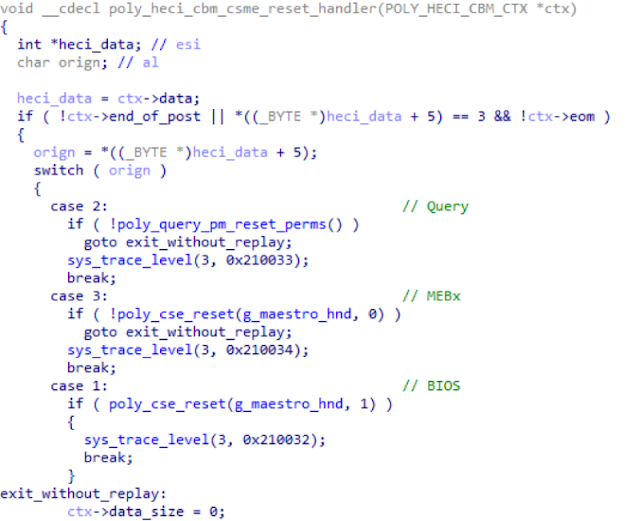 |
| Figure 8. Disassembler listing for the function responsible for handling HECI ME reset commands |
Exploitation case: vulnerability CVE-2018-4251
We analyzed several platforms from a number of manufacturers, including Lenovo and Apple MacBook Prо laptops. The Yoga and ThinkPad computers we examined did NOT have any issues related to Manufacturing Mode. But we found that Apple laptops on Intel chipsets are running in Manufacturing Mode. After this information was reported to Apple, the vulnerability (CVE-2018-4251) was patched in macOS High Sierra update 10.13.5.Local exploitation of INTEL-SA-00086
By exploiting CVE-2018-4251, an attacker could write old versions of Intel ME (such as versions containing vulnerability INTEL-SA-00086) to memory without needing an SPI programmer or access to the HDA_SDO bridge—in other words, without physical access to the computer. Thus, a local vector is possible for exploitation of INTEL-SA-00086, which enables running arbitrary code in ME.Notably, in the notes for the INTEL-SA-00086 security bulletin, Intel does not mention enabled Manufacturing Mode as a method for local exploitation in the absence of physical access. Instead, the company incorrectly claims that local exploitation is possible only if access settings for SPI regions have been misconfigured. So to keep users safe, we decided to describe how to check the status of Manufacturing Mode and how to disable it.
What can users do?
Intel System Tools includes MEInfo (and, for mobile and server platforms respectively, TXEInfo and SPSInfo) in order to allow obtaining thorough diagnostic information about the current state of ME and the platform overall. We demonstrated this utility in previous research about the undocumented HAP (High Assurance Platform) mode and how to disable ME [6]. The utility, when called with the -FWSTS flag, displays a detailed description of status HECI registers and the current status of Manufacturing Mode (when the fourth bit of the FWSTS status register is set, Manufacturing Mode is active).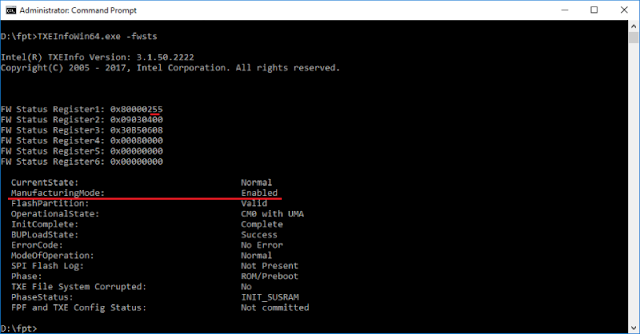 |
| Figure 9. Example of MEInfo output |
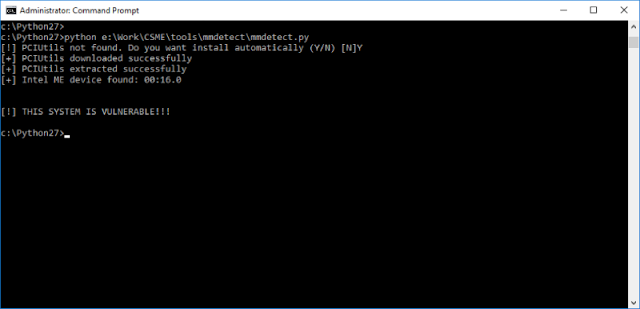 |
| Figure 10. mmdetect script |
Here is what happens when we enter -CLOSEMNF:
 |
| Figure 11. Process of closing Manufacturing Mode with FPT |
In this example, we used the NO parameter for -CLOSEMNF to avoid resetting the platform, as would otherwise happen by default immediately after closing Manufacturing Mode.
Conclusion
Our research shows that Intel ME has a Manufacturing Mode problem, and that even giant manufacturers such as Apple are not immune to configuration mistakes on Intel platforms. Worse still, there is no public information on the topic, leaving end users in the dark about weaknesses that could result in data theft, persistent irremovable rootkits, and even "bricking" of hardware.We also suspect that the ability to reset ME without resetting the main CPU may lead to yet additional security issues, due to the states of the BIOS/UEFI and ME falling out of sync.
[1] Intel Management Engine Critical Firmware Update, Intel-SA-00086
[2] GitHub - chipsec/chipsec: Platform Security Assessment Framework
[4] Fast, secure and flexible OpenSource firmware, Coreboot
[5] Mark Ermolov, Maxim Goryachy, How to Become the Sole Owner of Your PC, PHDays VI, 2016
[6] Mark Ermolov, Maxim Goryachy, Disabling Intel ME 11 via undocumented mode, Positive Technologies blog
[7] Intel ME Manufacturing Mode Detection Tools
[8] Safeguarding rootkits: Intel BootGuard, Alexander Ermolov
[9] Dmitry Sklyarov. Intel ME: Flash File System. Explained
Author: Maxim Goryachy
Article Link: http://blog.ptsecurity.com/2018/10/intel-me-manufacturing-mode-macbook.html
